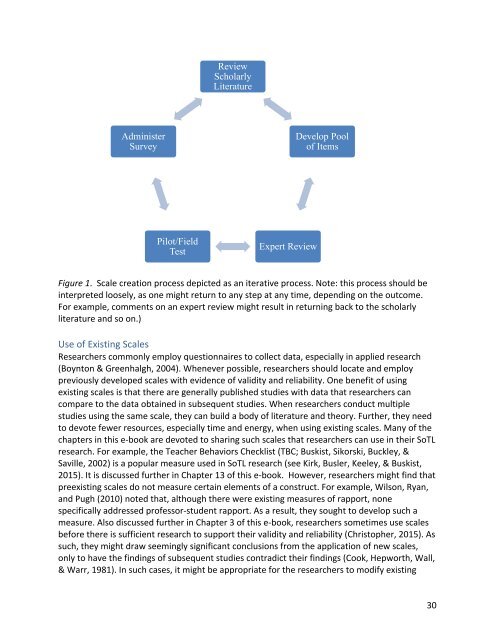A COMPENDIUM OF SCALES for use in the SCHOLARSHIP OF TEACHING AND LEARNING
compscalesstl
compscalesstl
You also want an ePaper? Increase the reach of your titles
YUMPU automatically turns print PDFs into web optimized ePapers that Google loves.
Review<br />
Scholarly<br />
Literature<br />
Adm<strong>in</strong>ister<br />
Survey<br />
Develop Pool<br />
of Items<br />
Pilot/Field<br />
Test<br />
Expert Review<br />
Figure 1. Scale creation process depicted as an iterative process. Note: this process should be<br />
<strong>in</strong>terpreted loosely, as one might return to any step at any time, depend<strong>in</strong>g on <strong>the</strong> outcome.<br />
For example, comments on an expert review might result <strong>in</strong> return<strong>in</strong>g back to <strong>the</strong> scholarly<br />
literature and so on.)<br />
Use of Exist<strong>in</strong>g Scales<br />
Researchers commonly employ questionnaires to collect data, especially <strong>in</strong> applied research<br />
(Boynton & Greenhalgh, 2004). Whenever possible, researchers should locate and employ<br />
previously developed scales with evidence of validity and reliability. One benefit of us<strong>in</strong>g<br />
exist<strong>in</strong>g scales is that <strong>the</strong>re are generally published studies with data that researchers can<br />
compare to <strong>the</strong> data obta<strong>in</strong>ed <strong>in</strong> subsequent studies. When researchers conduct multiple<br />
studies us<strong>in</strong>g <strong>the</strong> same scale, <strong>the</strong>y can build a body of literature and <strong>the</strong>ory. Fur<strong>the</strong>r, <strong>the</strong>y need<br />
to devote fewer resources, especially time and energy, when us<strong>in</strong>g exist<strong>in</strong>g scales. Many of <strong>the</strong><br />
chapters <strong>in</strong> this e-book are devoted to shar<strong>in</strong>g such scales that researchers can <strong>use</strong> <strong>in</strong> <strong>the</strong>ir SoTL<br />
research. For example, <strong>the</strong> Teacher Behaviors Checklist (TBC; Buskist, Sikorski, Buckley, &<br />
Saville, 2002) is a popular measure <strong>use</strong>d <strong>in</strong> SoTL research (see Kirk, Busler, Keeley, & Buskist,<br />
2015). It is discussed fur<strong>the</strong>r <strong>in</strong> Chapter 13 of this e-book. However, researchers might f<strong>in</strong>d that<br />
preexist<strong>in</strong>g scales do not measure certa<strong>in</strong> elements of a construct. For example, Wilson, Ryan,<br />
and Pugh (2010) noted that, although <strong>the</strong>re were exist<strong>in</strong>g measures of rapport, none<br />
specifically addressed professor-student rapport. As a result, <strong>the</strong>y sought to develop such a<br />
measure. Also discussed fur<strong>the</strong>r <strong>in</strong> Chapter 3 of this e-book, researchers sometimes <strong>use</strong> scales<br />
be<strong>for</strong>e <strong>the</strong>re is sufficient research to support <strong>the</strong>ir validity and reliability (Christopher, 2015). As<br />
such, <strong>the</strong>y might draw seem<strong>in</strong>gly significant conclusions from <strong>the</strong> application of new scales,<br />
only to have <strong>the</strong> f<strong>in</strong>d<strong>in</strong>gs of subsequent studies contradict <strong>the</strong>ir f<strong>in</strong>d<strong>in</strong>gs (Cook, Hepworth, Wall,<br />
& Warr, 1981). In such cases, it might be appropriate <strong>for</strong> <strong>the</strong> researchers to modify exist<strong>in</strong>g<br />
30


